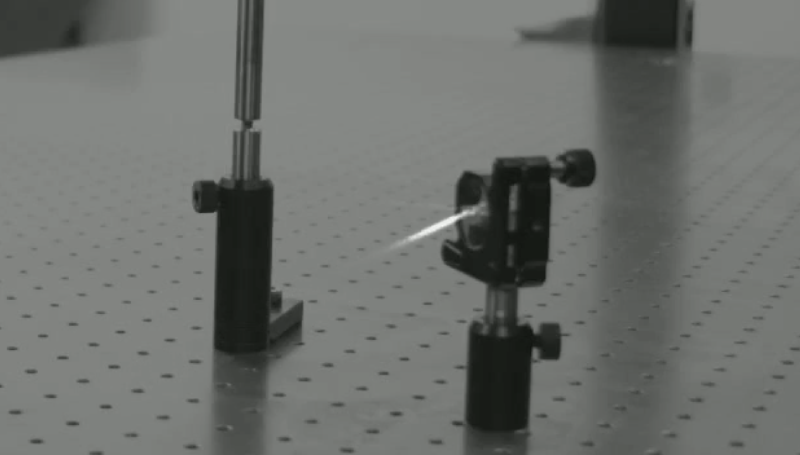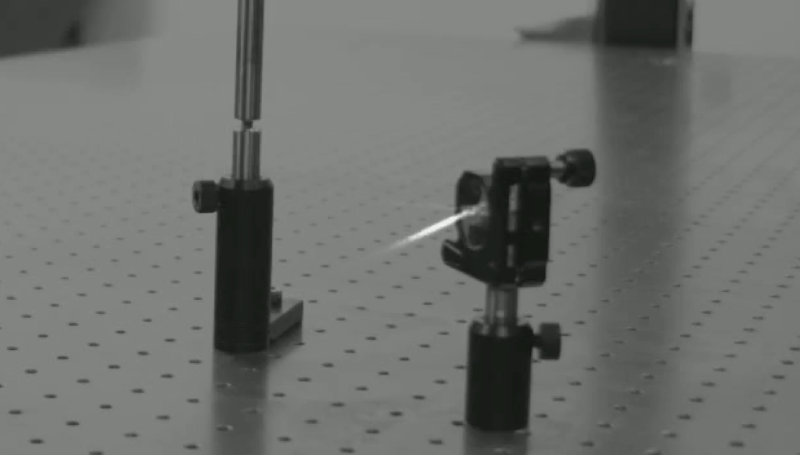Capturing the Path of a Light Pulse
A team of researchers has captured high-speed footage of a light pulse traveling in three dimensions as it bounced off of a series of mirrors [1]. Previous efforts have only recorded pulses moving in 2D. The team’s achievement was made possible by a new high-resolution, high-speed camera. The demonstration shows the emerging capabilities of high-speed image sensors and hints at potential applications in technologies such as time-resolved medical imaging and car safety features.
In time-resolved imaging, it is often important to track the precise position of a light pulse. But this task is more complicated than observing any other object’s motion because the pulse travels as fast as the scattered light that is used to detect the pulse’s path. Imagine the pulse bouncing among a series of mirrors in 3D as it travels through fog. A high-speed camera can capture a 2D movie of the pulse’s position, but researchers have had trouble with the third dimension, depth—the distance between the pulse and the camera. Like a star in the night sky, a laser pulse is easy to locate in the two dimensions of a camera’s field of view, but its distance is harder to gauge.
In the past few years, researchers have begun experimenting with a new trick for detecting depth. It’s based on the fact that the “apparent” velocity of the pulse—the velocity with which it appears to move across the camera’s 2D field of view—depends on the pulse’s true direction of motion. A pulse moving toward the camera can have an apparent velocity higher than the speed of light, c, because of the time it takes for fog-scattered light to reach the camera from different locations; a pulse moving away has a much lower apparent velocity, even though the true speed is always c. Determining this directional information from the apparent velocity allows the depth coordinate to be calculated.
This technique requires a sophisticated detector, one that can be triggered on short timescales and that provides high spatial resolution. Last year, a team led by Daniele Faccio of the University of Glasgow in the UK demonstrated elements of the 3D-pulse-tracking technique for a laser pulse moving mostly in 2D, with only slight variations in the depth dimension [2]. The detector had the necessary high time resolution but had too few pixels to fully implement the technique for more general 3D motion.
In 2019, Edoardo Charbon of the Swiss Federal Institute of Technology in Lausanne and colleagues developed a new detector with very high space and time resolution. The detector is a megapixel camera that can capture up to 24,000 frames per second and can be triggered with an accuracy of tens of picoseconds, as the team reported last year [3].
In their new experiment, Charbon and colleagues sent light pulses through a fog-filled course involving several mirrors. The team’s camera recorded movies by taking a single photo with a different delay time for each successive pulse. So each photo recorded fog-scattered photons from the pulse at a different location. “It’s like sending many messengers, and some of the messengers return and report back to you,” Charbon says. “And they tell you, ‘I got that far.’”
To process the data, the researchers first used a machine-learning technique that could—without human intervention—break up the observed set of light flashes into straight-line portions of the pulse’s path (a surprisingly challenging task by other means). Next, they reconstructed the pulse’s full spacetime trajectory by fitting the data to a theory that accounts for the apparent velocity effects.
The experiment is an impressive demonstration of the capabilities of the team’s megapixel, high-speed camera, says image sensor expert Eric Fossum of Dartmouth College in New Hampshire. The researchers say that their system could potentially be used for noninvasive 3D monitoring in medical imaging or for a technology that can effectively “see” around corners. For example, it might warn a driver of an out-of-sight child about to run into the road, based on calculating the 3D positions of photons reflected from multiple surfaces, Charbon says.
–Erika K. Carlson
Erika K. Carlson is a Corresponding Editor for Physics based in New York City.
References
- K. Morimoto et al., “Superluminal motion-assisted four-dimensional light-in-flight imaging,” Phys. Rev. X 11, 011005 (2021).
- Y. Zheng et al., “Computational 4D imaging of light-in-flight with relativistic effects,” Photonics Res. 8, 1072 (2020).
- K. Morimoto et al., “Megapixel time-gated SPAD image sensor for 2D and 3D imaging applications,” Optica 7, 346 (2020).





